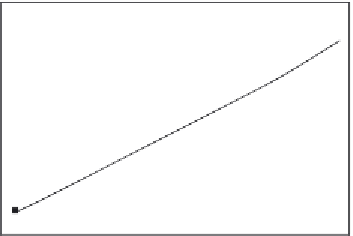Biomedical Engineering Reference
In-Depth Information
100
90
80
70
60
50
2.1
2.15
2.2
2.25
2.3
2.35
2.4
Fractal dimension,
D
f
Figure 10.11
Increase in the binding rate coefficient, k, with an increase in the fractal dimension, D
f.
Figure 10.11
and
Table 10.8
show the increase in the binding rate coefficient,
k
, with
an increase in the fractal dimension,
D
f
, for a single-fractal analysis. For the data shown in
Figure 10.11
, the binding rate coefficient,
k
, is given by:
D
4
:
289
0
:
537
k
¼ð
2
:
201
0
:
112
Þ
ð
10
:
9
Þ
f
The fit is good. Only three data points are available. The availability of more data points
would lead to a more reliable fit. The binding rate coefficient,
k
, (for these reversibility runs)
is very sensitive to the fractal dimension,
D
f
, or the degree of heterogeneity that exists on the
biosensor surface as noted by the high order of dependence between four and four and a half
(equal to 4.289) exhibited.
Cao and Duan (2005)
analyzed the influence of the carrier gases argon, nitrogen and air on
the detection of 145 ppm of NH
3
at 22.1
C using their optical fiber-based evanescent ammo-
nia sensor. These authors noted that the response time of the sensor varied clearly for the dif-
ferent gases. They also noted that when air was used as the carrier gas the absorption change
was the highest, and when Argon was used as the carrier gas, the absorption change was the
lowest.
Figure 10.12a
shows the binding of 145 ppm NH
3
in air (carrier gas) to the optical fiber-based
evanescent ammonia sensor (
Cao and Duan, 2005
). A dual-fractal analysis is required to ade-
quately describe the binding kinetics. The values of (a) the binding rate coefficient,
k
, and the
fractal dimension,
D
f
, for a single-fractal analysis, and (b) the binding rate coefficients,
k
1
and
k
2
, and the fractal dimensions,
D
f1
and
D
f2
, for a dual-fractal analysis are given in
Table 10.9
. It is of interest to note that as the fractal dimension increases by a factor of 1.53 from
a value of
D
f1
equal to 1.9298 to
D
f2
equal to 2.7950, the binding rate coefficient increases by a
factor of 2.76 from a value of
k
1
equal to 37.39 to
k
2
equal to 103.3.




























